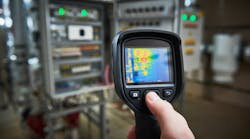Tim, a thermographer, arrived at the plant of a new client, ready to perform a series of thermographic scans. As Tim and his escort, Greg, walked to the first feeder panel, he noticed black dust from a rubber-like material processed in the plant covering everything, although there didn’t seem to be airborne particulates at the time.
That feeder panel was also covered in the same dust. When Greg started to open the panel, Tim stopped him. “We need to brush and vacuum all this dust off before opening the panel,” he said. Greg replied, “Oh, that’s normal. We just work around it.”
But in what sense was it normal? There is a difference between normally being sloppy and conforming to the conditions expected for normal operation and maintenance of the equipment.
A normal operating condition is required for performing energized work under normal precautions. If you don’t have a normal operating condition, you must assume each possible danger exists unless you can rule it out.
Thermography is performed while equipment is energized, and this situation puts Tim in a bind.
Requirements
A normal operating condition exists when all six of the following requirements are met [110.4(D)]:
- The equipment is properly installed. This means the equipment is installed per the applicable industry codes and standards, as well as the manufacturer’s instructions (unless they conflict with the industry codes and standards, in which case there’s a problem to sort). If Tim had seen a ground rod tied to this feeder panel, he’d have been able to say this condition wasn’t met (grounding is done on the supply side, not the load side).
- The equipment is properly maintained. This means the equipment has been maintained per the applicable industry codes and standards, as well as the manufacturer’s recommendations. One of the requirements you will find when you consult these resources is there’s a record of maintenance. If Tim had asked to see the maintenance records and gotten a blank look, he would not have been able to confirm this equipment had been maintained at all. But the dirty condition already told him it has not been properly maintained.
- The equipment is used per instructions included with the listing and labeling, and per the manufacturer’s instructions. The meaning here is obvious. If Tim had seen a floor fan blowing onto a circuit breaker (a “solution” to trips from overload), he’d know that breaker is not being used as intended.
- The equipment doors are closed and secured. If Tim had noticed a door is ajar, the client would have gotten a “Fail” here.
- All equipment covers are in place and secured. If Tim had noticed an equipment door has 12 bolts and two of them are missing, he would have known this condition is not satisfied.
- There is no evidence of impending failure. You can suspect impending failure where there’s evidence of arcing, overheating, loose or bound equipment parts, visible damage, or deterioration. If Tim had seen any of these conditions, he would have been correct in canceling the thermography work until these were corrected. That’s not just from a safety standpoint. Thermography logically comes after these kinds of things are corrected.
Now, what should Tim’s response have been to Greg’s “Oh, that’s normal” comment? What would your response have been? If you were Tim’s boss, what response would you expect him to give? What response would you want him to give?
The answer to that last question depends upon the level of integrity at your company. Or maybe it depends on how much you personally value Tim’s safety.




